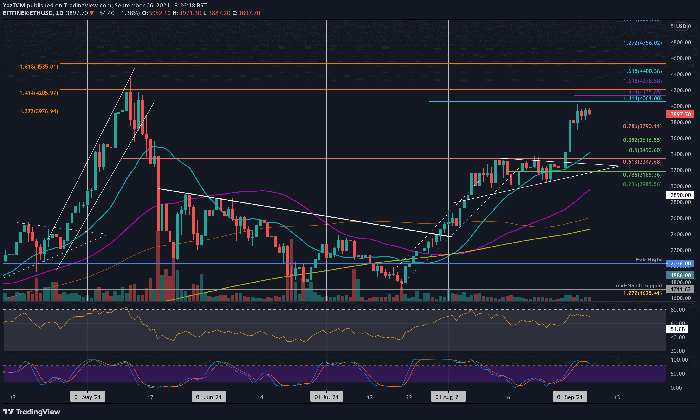The recent Bitcoin price crash has sent shockwaves throughout the cryptocurrency market, impacting investors and traders alike. After reaching an impressive all-time high of nearly $112,000 just a few days prior, the sudden drop to $103,000 raised concerns about market stability and future trends. This significant bitcoin price drop has not only affected Bitcoin’s market capitalization but has also triggered steep declines in altcoin prices, resulting in a collective loss of approximately $200 billion in the last 48 hours. As traders scramble to understand the implications of this crash, bitcoin news is permeating discussions across platforms, driving heightened interest in the dynamics of crypto trading. In this tumultuous atmosphere, both seasoned and novice investors find themselves questioning whether this is merely a temporary setback or a sign of a deeper market shift.
In the wake of the dramatic downturn in Bitcoin’s value, the ripple effects throughout the digital asset sphere have been profound. Following an exhilarating surge to unprecedented heights, the recent Bitcoin price collapse has highlighted the volatility inherent in cryptocurrency exchanges. As Bitcoin battles to regain its footing, many other digital currencies are also suffering sharp declines, further complicating the landscape for crypto enthusiasts. Investors are now faced with a flurry of alternative digital assets, each grappling with the implications of the overarching price drops. As the hype surrounding Bitcoin wanes, the spotlight shifts to broader cryptocurrency dynamics and the potential long-term effects on market health.
Understanding the Bitcoin Price Crash and Its Impact on the Market
In recent days, the cryptocurrency market has dramatically experienced severe turmoil, primarily characterized by a significant Bitcoin price crash. Following a remarkable surge to nearly $112,000, Bitcoin has plummeted to a low of approximately $103,000, triggering widespread panic among traders and investors. This shocking decline has been largely attributed to escalating geopolitical tensions, notably between the US and China, leading to a lack of investor confidence that has rippled through the entire crypto market.
The immediate impact of the Bitcoin price drop has not only affected its market capitalization but has also put immense pressure on altcoin prices. As Bitcoin often serves as a bellwether for the cryptocurrency market, its decline has resulted in substantial losses across various altcoins, with many experiencing double-digit percentage drops. Understanding the factors behind this price crash is crucial for investors as it highlights the volatile nature of cryptocurrency trading and the importance of market sentiment in driving price movements.
Trends in Altcoin Prices: Insights During Bitcoin’s Decline
As Bitcoin tumbles, the altcoin market has been subjected to unprecedented price fluctuations, with several coins facing dramatic declines. Notable cryptocurrencies like Ethereum, XRP, and Cardano have seen their values dwindle significantly, contributing to an overall decrease in the total cryptocurrency market cap. These trends indicate that altcoin prices are closely linked to Bitcoin’s performance; when Bitcoin suffers a setback, the alternative coins often follow suit, amplifying investor anxiety and fear.
However, not all altcoins are feeling the adverse effects of Bitcoin’s current situation. CRO has emerged as an outlier, experiencing substantial growth while its counterparts falter. This divergence highlights the potential for certain cryptocurrencies to thrive amidst general market downturns. For crypto traders, recognizing such trends and patterns becomes essential in navigating the volatile climates that characterize the cryptocurrency landscape.
What Investors Should Know About Crypto Trading During Crises
Navigating the cryptocurrency market requires agility, particularly during periods of market instability such as the one we are currently witnessing. Investors should be wary of making impulsive decisions solely based on the current Bitcoin price crash. Key strategies, including employing stop-loss orders and diversifying portfolios, can help mitigate unexpected losses during turbulent times. Increased education on market signals and news trends is crucial for those looking to make informed trading decisions.
Additionally, maintaining a long-term perspective can be beneficial for investors. While the short-term fluctuations of Bitcoin and altcoins can be alarming, a broader view often reveals opportunities for growth. Seasoned investors frequently emphasize the importance of patience and strategic planning, especially during significant downturns. As the cryptocurrency trading landscape continues to evolve, leveraging research and historical data will empower traders to make more calculated moves.
Key Factors Influencing Bitcoin’s Price Movements
The recent Bitcoin price crash can be traced back to multiple factors, chiefly geopolitical events and market reactions to policy changes. The announcement of new tariffs by the US government has created an atmosphere of uncertainty that negatively impacts institutional investments. Investors need to keep a pulse on how external economic factors interplay with the cryptocurrency market, as these influences directly affect Bitcoin’s price and its trajectory.
Moreover, market psychology plays a quintessential role in shaping Bitcoin’s price movements. The rapid sell-off observed after the peak suggests that many traders reacted emotionally to news and market fluctuations rather than relying on analytical insights. Investors must understand the psychology behind trading behaviors, as fear and greed can lead to erratic price changes that amplify volatility in the cryptocurrency arena.
Current Market Sentiment: Analyzing the Reaction to Bitcoin’s Drop
Market sentiment is at an all-time low following Bitcoin’s steep decline, as many traders express concerns over potential future drops. This pessimistic view can lead to increased selling pressure as market participants flee from perceived risk, resulting in larger drops in altcoin prices. On the other hand, this bearish sentiment can also present unique buying opportunities for those who believe in the long-term potential of cryptocurrencies.
It’s crucial for investors to assess market sentiment critically and factor it into their investment strategies. Remaining level-headed and seeking to understand market dynamics can help investors identify whether the prevailing narrative is based on sound reasoning or fear-driven hysteria. By analyzing sentiment indicators alongside market data, traders can make more informed decisions that may just lead them to capitalize on future market recoveries.
Bitcoin Market Dominance: Implications for Crypto Traders
Bitcoin has consistently maintained a dominant position within the cryptocurrency market, holding approximately 61.3% of the total market cap. This dominance means that Bitcoin’s performance heavily influences the price actions of altcoins, causing traders to closely monitor BTC’s movements. As Bitcoin’s price continues to fluctuate, its dominance often reflects market confidence and investor preferences, playing a pivotal role in shaping overall market trends.
For traders, understanding Bitcoin’s market dominance is vital for making strategic decisions. Traders can utilize tools like the Bitcoin dominance index to gauge market trends and potentially anticipate movements in altcoin prices. This knowledge allows investors to optimize their portfolios, balancing risk and reward effectively by capitalizing on Bitcoin’s influence across the broader cryptocurrency landscape.
Geopolitical Events and Their Impact on Cryptocurrency Prices
Geopolitical tensions have increasingly shown a direct correlation with cryptocurrency market trends. The latest escalation in U.S.-China relations has contributed to the recent Bitcoin price crash, causing concern about future economic stability. Investors should pay close attention to news from these geopolitical hotspots, as decisions made at government levels can quickly impact market confidence, precipitating significant price movements in cryptocurrencies.
Moreover, understanding how global events affect market dynamics can provide valuable insight for traders. Tensions around trade agreements or economic sanctions often lead to increased volatility in asset prices, including cryptocurrencies. By being aware of external influences, investors can better anticipate potential risks and adjust their strategies to suit the rapidly changing landscape.
Long-Term Strategies for Investing in a Volatile Crypto Market
Investing in cryptocurrencies demands a robust long-term strategy, especially during times marked by volatility such as the current market situation. Instead of panicking and making swift trades, investors should consider adopting a dollar-cost averaging approach. This method involves consistently investing a fixed amount over time, helping to mitigate the effects of short-term price fluctuations and reducing the impact of volatility on overall investment.
Furthermore, conducting thorough research and being knowledgeable about the projects behind various cryptocurrencies can lead to more informed investment choices. By focusing on fundamentals rather than market sentiment, long-term investors can align their portfolios with cryptocurrencies that possess solid use cases and growth potential. This disciplined approach often yields better returns as the market stabilizes following downturns.
Emerging Trends in Crypto Trading: What to Watch For
As the cryptocurrency market continues to grow and evolve, several emerging trends are worth watching for traders seeking advantageous positions. One significant trend is the increasing adoption of decentralized finance (DeFi) platforms, which allow users to engage in various financial activities without traditional intermediaries. As interest in these services rises, it may lead to shifts in trading behaviors and investment strategies.
Additionally, the growing prevalence of algorithmic trading and automated trading bots is revolutionizing the way traders interact with the market. These technologies enable faster execution of trades and real-time data analysis, giving traders an edge during volatile conditions. Keeping abreast of these trends can prepare investors to adapt their trading strategies in response to changing market conditions, ultimately leading to smarter and potentially more profitable decision-making.
Frequently Asked Questions
What caused the recent Bitcoin price crash to $103,000?
The recent Bitcoin price crash to $103,000 was primarily driven by escalating tensions between the US and China, particularly after US President Trump’s remarks about new tariffs against the EU. This announcement, combined with a failure of Bitcoin to maintain its previous high of nearly $112,000, led to a rapid drop in its price.
How does the Bitcoin price drop affect other altcoin prices?
The Bitcoin price drop significantly impacted altcoin prices, with many major cryptocurrencies like Ethereum and XRP experiencing substantial losses, up to 9%. This market-wide decline correlates to Bitcoin’s dominance, as when BTC drops, it often leads to a decrease in market confidence, causing altcoins to bleed value as well.
Is the current Bitcoin price drop an indicator of a longer-term trend in the cryptocurrency market?
While it’s hard to predict long-term trends, the current Bitcoin price drop might reflect increased volatility in the cryptocurrency market. Factors such as regulatory changes, market sentiment, and external economic pressures can all play a role in future price movements.
What strategies can crypto traders use during a Bitcoin price crash?
During a Bitcoin price crash, crypto traders can consider strategies like dollar-cost averaging, safeguarding by diversifying into stable altcoins, setting stop-loss orders to limit potential losses, and staying informed on market trends for better decision-making.
What does the Bitcoin price crash mean for new investors in the cryptocurrency market?
For new investors, the Bitcoin price crash presents both risks and opportunities. It emphasizes the importance of conducting thorough research before investing and could offer lower entry prices for Bitcoin or promising altcoins, provided they are prepared for potential continued volatility.
How does the fear surrounding Bitcoin price crashes influence investor behavior?
Fear surrounding Bitcoin price crashes often leads to panic selling among investors, exacerbating the price decline. Conversely, it can also motivate savvy investors to buy during dips, viewing the lower prices as an opportunity to accumulate more assets.
What role do market cap changes play during a Bitcoin price crash?
Market cap changes during a Bitcoin price crash are significant as they reflect overall market confidence. A decline in Bitcoin’s market cap, which has fallen by about $200 billion currently, indicates a broader sell-off in the cryptocurrency market, often leading to increased bearish sentiment.
| Key Points | Details |
|---|---|
| Bitcoin Price Crash | Bitcoin’s price has dropped to $103,000, a 12-day low, largely influenced by geopolitical tensions. |
| Market Impact | The cryptocurrency market shed approximately $200 billion within 48 hours. |
| Altcoins Performance | Many altcoins, including Ethereum and DOGE, saw significant price drops, with some down 9% or more. |
| CRO Performance | CRO is an exception, gaining 17% increase in the same period. |
| Bitcoin Market Domination | Bitcoin’s market cap fell to $2.06 trillion, while its dominance rose to 61.3%. |
Summary
The Bitcoin Price Crash has been significant, with the cryptocurrency plummeting to a low of $103,000 amid escalating political tensions between the US and China. The broader market has also suffered, resulting in a loss of $200 billion in just two days. Furthermore, altcoins faced even steeper declines, highlighting the volatility and unpredictability of the crypto market. While certain coins like CRO defied the trend by increasing in value, the overall scenario has caused concern among investors and market analysts alike.
The recent turmoil in the cryptocurrency market has sparked significant concern among investors, as evidenced by the Bitcoin price crash that has seen the digital asset plunge to a 12-day low of $103,000. This dramatic downturn follows the cryptocurrency’s ascent to almost $112,000, marking a stark reversal of fortune that has also decimated altcoin prices across the board. The latest bitcoin news indicates that heightened geopolitical tensions, particularly between the U.S. and China, have further fueled investor anxiety, triggering a widespread sell-off. As crypto trading activity spikes, many are left wondering whether this Bitcoin price drop is just a temporary blip or a sign of more prolonged challenges ahead in the market. With a staggering $200 billion evaporating from the crypto market within just 48 hours, the implications of this crash extend far beyond Bitcoin alone, raising critical questions about the overall stability and future of digital currencies.
In light of the recent developments within the crypto ecosystem, it’s essential to explore the fallout from the Bitcoin price collapse. The sharp decline in Bitcoin’s value has not only affected its own price trajectory but has also set off alarm bells across the alternative cryptocurrency arena. As altcoins experience steep downturns in their market valuations, many investors are left grappling with the ramifications of a volatile trading environment. This situation underscores the interconnected nature of the cryptocurrency landscape, where fluctuations in Bitcoin often herald similar movements in altcoin prices. Consequently, the current scenario serves as a stark reminder of the inherent risks and unpredictability associated with cryptocurrency investments.















